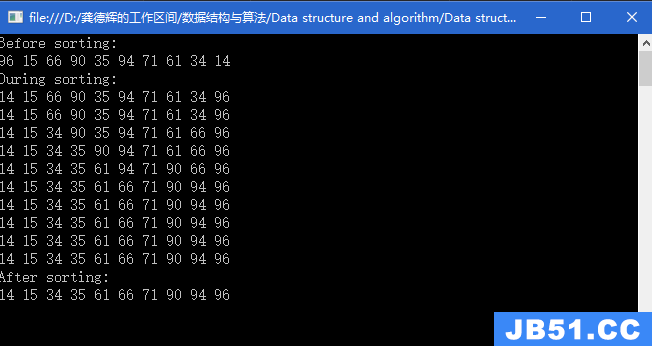《数据结构》实验三:栈和队列实验
一..实验目的
巩固栈和队列数据结构,学会运用栈和队列。
1.回顾栈和队列的逻辑结构和受限操作特点,栈和队列的物理存储结构和常见操作。
2.学习运用栈和队列的知识来解决实际问题。
3.进一步巩固程序调试方法。
4.进一步巩固模板程序设计。
二.实验时间
准备时间为第5周到第6周,具体集中实验时间为6周第2次课。2个学时。
三.实验内容
1.自己选择顺序或链式存储结构,定义一个空栈类,并定义入栈、出栈、取栈元素基本操作。然后在主程序中对给定的N个数据进行验证,输出各个操作结果。
2.自己选择顺序或链式存储结构,定义一个空栈队列,并定义入栈、出栈、取栈元素基本操作。然后在主程序中对给定的N个数据进行验证,输出各个操作结果。3.编程实现一个十进制数转换成二进制数。要求,要主程序中输出一个10进度数,输出其对应的2进制数序列。
四. 实验代码:
(1)栈的实现
# ifndef Seqstack_H
# define Seqstack_H
const int StackSize=10;
template <class DataType>
class SeqStack
{
public:
SeqStack();
~SeqStack(){}
void Push(DataType x);
DataType pop();
DataType GetTop();
int empty();
private:
DataType data[StackSize];
int top;
};
# endif
# include<iostream>
using namespace std;
template<class Datatype>
SeqStack<Datatype>::SeqStack()
{
top=-1;
}
template<class DataType>
void SeqStack<DataType>::Push(DataType x)
{
if (top==StackSize-1)throw"上溢";
top++;
data[top]=x;
}
template <class DataType>
DataType SeqStack<DataType>::pop()
{
DataType x;
if(top==-1)throw"下溢";
x=data[top--];
return x;
}
template<class DataType>
DataType SeqStack<DataType>::GetTop()
{
if(top==-1)
return data[top];
}
template<class DataType>
int SeqStack<DataType>::empty()
{
if(top==-1) return 1;
else return 0;
}
void main()
{
SeqStack<int>S;
if(S.empty())
cout<<"栈为空"<<endl;
else
cout<<"栈为空"<<endl;
cout<<"对8和15进行入栈操作:"<<endl;
S.Push(8);
S.Push(15);
cout<<"栈顶元素为:"<<endl;
cout<<S.GetTop()<<endl;
cout<<"执行第一次出栈操作:"<<endl;
S.pop();
cout<<"栈顶元素为:"<<endl;
cout<<S.GetTop()<<endl;
}
(2)链队列的实现
# ifndef LinkQueue_H
# define LinkQueue_h
template <class DataType>
struct Node
{
DataType data;
Node<DataType>*next;
};
template <class DataType>
class LinkQueue
{
public:
LinkQueue();
~LinkQueue();
void EnQueue(DataType x);
DataType DeQueue();
DataType GetQueue();
int empty();
private:
Node<DataType>*front,*rear;
};
# endif
# include<iostream>
using namespace std;
template <class DataType>
LinkQueue<DataType>::LinkQueue()
{
Node<DataType>*s=NULL;
s=new Node<DataType>;
s->next=NULL;
front=rear=s;
}
template<class DataType>
LinkQueue<DataType>::~LinkQueue()
{
Node<DataType>*p=NULL;
while(front !=NULL)
{
p=front ->next;
delete front;
front=p;
}
}
template<class DataType>
void LinkQueue<DataType>::EnQueue(DataType x)
{
Node<DataType>*s=NULL;
s=new Node<DataType>;
s->data=x;
s->next=NULL;
rear->next=s;rear=s;
}
template <class DataType>
DataType LinkQueue<DataType>::DeQueue()
{
Node<DataType>*p=NULL;
int x;
if(rear==front)throw"下溢";
p=front->next;
x=p->data;
front->next=p->next;
if(p->next==NULL) rear=front;
delete p;
return x;
}
template<class DataType>
DataType LinkQueue<DataType>::GetQueue()
{
if (front !=rear)
return front->next->data;
}
template <class DataType>
int LinkQueue<DataType>::empty ()
{
if(front==rear)
return 1;
else
return 0;
}
void main()
{
LinkQueue<int>Q;
if (Q.empty ())
cout<<"队列为空"<<endl;
else
cout<<"队列为空"<<endl;
cout<<"元素为8和17执行入队操作:"<<endl;
try
{
Q.EnQueue(10);
Q.EnQueue(15);
}
catch(char *wrong)
{
cout<<wrong<<endl;
}
cout<<"查看队头元素:"<<endl;
cout<<Q.GetQueue ()<<endl;
cout<<"执行出队操作:"<<endl;
try
{
Q.DeQueue ();
}
catch(char*wrong)
{
cout<<wrong<<endl;
}
cout<<"查看队头元素:"<<endl;
cout<<Q.GetQueue <<endl;
}


